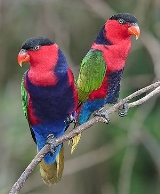
Black-capped Lory
Encyclopedia
The Black-capped Lory also known as Western Black-capped Lory or the Tricolored Lory, is a parrot
found in New Guinea
and adjacent smaller islands. It is a colorful and relatively robust lory (31 cm). There are seven subspecies
, all with green wings, red heads and body around the wing, a black cap, grey-black cere, yellow underwings, and blue legs and belly. Most also have a blue nape and mantle (area between wings on the back). It remains overall widespread and common, but the subspecies cyanuchen is relatively rare, with fewer than 5000 individuals remaining.
Parrot
Parrots, also known as psittacines , are birds of the roughly 372 species in 86 genera that make up the order Psittaciformes, found in most tropical and subtropical regions. The order is subdivided into three families: the Psittacidae , the Cacatuidae and the Strigopidae...
found in New Guinea
New Guinea
New Guinea is the world's second largest island, after Greenland, covering a land area of 786,000 km2. Located in the southwest Pacific Ocean, it lies geographically to the east of the Malay Archipelago, with which it is sometimes included as part of a greater Indo-Australian Archipelago...
and adjacent smaller islands. It is a colorful and relatively robust lory (31 cm). There are seven subspecies
Subspecies
Subspecies in biological classification, is either a taxonomic rank subordinate to species, ora taxonomic unit in that rank . A subspecies cannot be recognized in isolation: a species will either be recognized as having no subspecies at all or two or more, never just one...
, all with green wings, red heads and body around the wing, a black cap, grey-black cere, yellow underwings, and blue legs and belly. Most also have a blue nape and mantle (area between wings on the back). It remains overall widespread and common, but the subspecies cyanuchen is relatively rare, with fewer than 5000 individuals remaining.
Subspecies
The subspecies vary considerably in color:- L. l. lory: West Papuan islands and Bird's Head PeninsulaBird's Head PeninsulaThe Bird's Head Peninsula or Doberai Peninsula is a large peninsula that makes up the northwest portion of the Province of West Papua, Indonesia.-Location and geography:...
. Blue of nape, mantle, and belly merge to cover most of body and are purple-blue. Red underwing coverts. Juvenile resembles erythrothorax or cyanuchen. - L. l. erythrothorax: The whole south coast of New Guinea east of Bird's Head Peninsula, and the SE north coast. Blue nape almost forms collar, blue comes halfway up belly. Yellow on wings. Blue mantle in two bands. Red underwing coverts.
- L. l. somu: Southern hill districts of central New Guinea. Red mantle and nape, blue only low on belly.
- L. l. salvadorii: Northwest coast of Papua New Guinea. Like erythrothorax but with blue-black underwing coverts.
- L. l. viridicrissalis: Northeast coast of Western New GuineaWestern New GuineaWest Papua informally refers to the Indonesian western half of the island of New Guinea and other smaller islands to its west. The region is officially administered as two provinces: Papua and West Papua. The eastern half of New Guinea is Papua New Guinea.The population of approximately 3 million...
. Like salvadorii but blue blacker everywhere. - L. l. jobiensis: YapenYapenYapen is an island of western New Guinea, Indonesia. The Yapen Strait separates Yapen and the Biak Islands to the north. It is in Cenderawasih Bay. To the west is Mios Num Strait between it and Mios Num Island, and the east Kurudu Island. The southeast are the Amboi Islands and the southwest...
and Mios NumMios NumMios Num is an island of western New Guinea, Indonesia, just west of Yapen. The Mios Num Strait separates it from Yapen. It is in Cenderawasih Bay. Numfoor and Biak are to the north, with Aruri Strait in between....
islands. Like salvadorii but paler breast and mantle bands. - L. l. cyanuchen: BiakBiakBiak features a tropical rainforest climate with nearly identical temperatures throughout the course of the year. The average annual temperature in the city is 27 degrees celsius, which is also generally the average temperature of each day in Biak...
island. Black of cap meets blue of nape, single blue mantle stripe.

